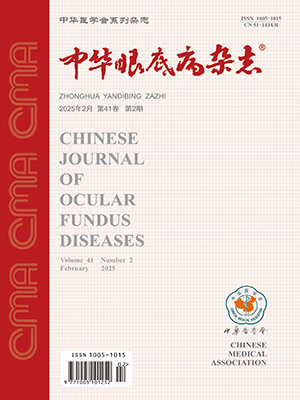| 1. |
Hood CT, Lee BJ, Jeng BH. Incidence, occurrence rate, and characteristics of suture-related corneal infections after penetrating keratoplasty[J]. Cornea, 2011, 30(6): 624-628. DOI: 10.1097/ICO.0b013e3182041755.
|
| 2. |
Relhan N, Forster RK, Flynn HW. Endophthalmitis: then and now[J]. Am J Ophthalmol, 2018, 187: xx-xxvii. DOI: 10.1016/j.ajo.2017.11.021.
|
| 3. |
Vaziri, K, Schwartz SG, Kishor K, et al. Endophthalmitis: state of the art[J]. Clin Ophthalmol, 2015, 8(9): 95-108. DOI: 10.2147/OPTH.S76406.
|
| 4. |
Malmin, A, Syre H, Ushakova A, et al. Twenty years of endophthalmitis: incidence, aetiology and clinical outcome[J/OL]. Acta Ophthalmol, 2021, 99(1): e62-e69[2020-06-22]. https://pubmed.ncbi.nlm.nih.gov/32567150/. DOI: 10.1111/aos.14511.
|
| 5. |
Thoms SS, Musch DC, Soong HK. Postoperative endophthalmitis associated with sutured versus unsutured clear corneal cataract incisions[J]. Br J Ophthalmol, 2007, 91(6): 728-730. DOI: 10.1136/bjo.2006.109827.
|
| 6. |
Sizmaz S, Esen E, Isik P, et al. Outcome and complications of combined phacoemulsification and 23-Gauge pars plana vitrectomy[J/OL]. J Ophthalmol, 2019, 2019: 7918237[2019-03-17]. https://pubmed.ncbi.nlm.nih.gov/31007952/. DOI: 10.1155/2019/7918237.
|
| 7. |
Leahey, AB, Avery RL, Gottsch JD, et al. Suture abscesses after penetrating keratoplasty[J]. Cornea, 1993, 12(6): 489-492. DOI: 10.1097/00003226-199311000-00005.
|
| 8. |
Alharbi SS, Alrajhi A, Alkahtani E. Endophthalmitis following keratoplasty: incidence, microbial profile, visual and structural outcomes[J]. Ocul Immunol Inflamm, 2014, 22(3): 218-223. DOI: 10.3109/09273948.2013.841956.
|
| 9. |
Lee BJ, Smith SD, Jeng BH. Suture-related corneal infections after clear corneal cataract surgery[J]. J Cataract Refract Surg, 2009, 35(5): 939-942. DOI: 10.1016/j.jcrs.2008.10.061.
|
| 10. |
Henry CR, Flynn HW, Miller D, et al. Delayed-onset endophthalmitis associated with corneal suture infections[J]. J Ophthalmic Inflamm Infect, 2013, 3(1): 51. DOI: 10.1186/1869-5760-3-51.
|
| 11. |
Gariano RF, Yoo R, Mah F. Suture-related endophthalmitis due to Morganella morganii[J/OL]. JCRS Online Case Reports, 2014, 2(1): e10-e11[2014-01-01]. https://doi.org/10.1016/j.jcro.2013.11.003. DOI: 10.1016/j.jcro.2013.11.003.
|
| 12. |
Danjoux JP, Reck AC. Corneal sutures: is routine removal really necessary?[J]. Eye (Lond), 1994, 8(Pt 3): 339-342. DOI: 10.1038/eye.1994.70.
|
| 13. |
Jackson H, Bosanquet R. Should nylon corneal sutures be routinely removed?[J]. Br J Ophthalmol, 1991, 75(11): 663-664. DOI: 10.1136/bjo.75.11.663.
|
| 14. |
Viana KÍS, Gordilho CT, Almeida FPP, et al. Combined pars plana vitrectomy (PPV) and phacoemulsification (phaco) versus PPV and deferred phaco for phakic patients with full-thickness macular hole (FTMH) and no significant cataract at baseline: 1-year outcomes of a randomized trial combined PPV/phaco vs PPV/deferred phaco for MH[J]. Graefe's Arch Clin Exp Ophthalmol, 2021, 259(1): 29-36. DOI: 10.1007/s00417-020-04731-7.
|
| 15. |
Melega MV, Reis R, Lira RPC, et al. Comparison between nylon and polyglactin sutures in pediatric cataract surgery: a randomized controlled clinical trial[J/OL]. Front Med (Lausanne), 2021, 8: 700793[2021-08-27]. https://pubmed.ncbi.nlm.nih.gov/34513873/. DOI: 10.3389/fmed.2021.700793.
|
| 16. |
Panchal B, Tyagi M, Pathengay A, et al. Endophthalmitis following suture removal-clinical outcomes and microbiological profile[J]. Semin Ophthalmol, 2019, 34(2): 115-123. DOI: 10.1080/08820538.2019.1590605.
|
| 17. |
Staropoli PC, Yannuzzi NA, David J, et al. Endophthalmitis after corneal suture removal[J/OL]. JCRS Online Case Reports, 2022, 10(2): e00073[2022-04-01]. https://doi.org/10.1097/j.jcro.0000000000000073. DOI: 10.1097/j.jcro.0000000000000073.
|
| 18. |
Heaven CJ, Davison CR, Cockcroft PM. Bacterial contamination of nylon corneal sutures[J]. Eye (Lond), 1995, 9(Pt 1): 116-118. DOI: 10.1038/eye.1995.18.
|
| 19. |
Grzybowski A, Turczynowska M, Kuhn F. The treatment of postoperative endophthalmitis: should we still follow the endophthalmitis vitrectomy study more than two decades after its publication?[J/OL]. Acta Ophthalmol, 2018. 96(5): e651-e654[2017-12-02]. https://pubmed.ncbi.nlm.nih.gov/29197165/. DOI: 10.1111/aos.13623.
|




